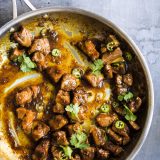Whether it’s an entire spit-roasted pig or the more accessible skillet-braised shoulder, pork frequently is the focus of feasts during religious festivals in Bali, a pocket of Hindu tradition in majority-Muslim Indonesia. And more often than not, that pork is paired with the national condiment, a thick, dark soy sauce called kecap manis.
The sauce sports a pronounced sweet-savory flavor, with hints of bitterness. Beyond simply pairing well with pork, it produces a richly lacquered glaze as it cooks, similar to Japanese teriyaki or Chinese Peking duck. That’s because the sugars in the sauce caramelize to a thick, dark, salty-sweet glaze.
The result is reminiscent of good barbecue. We were particularly drawn to a recipe known as babi kecap, in which the richness of tender, savory pork neck or belly is balanced by salty soy and the slightly bitter molasses-like f lavor in the kecap manis. Served with rice, it is often prepared in the days leading up to Nyepi, the Balinese New Year. But it can be an elaborate affair, calling for 20 or more spices and herbs.
So we based our version on a recipe from Charmaine Solomon’s “Encyclopedia of Asian Food,” which significantly simplifies both ingredients and method. Solomon starts by stir-frying diced pork neck with shallots, ginger and garlic, then adds kecap manis, soy sauce and chilies. Uncovered, the sauce quickly cooks down to a sticky, rich glaze.
However, even this simplified dish presented challenges. Chief among them is that kecap manis can be hard to find in the U.S. We needed a workaround that did justice to the complexity of the original, which is made by boiling down soy sauce with palm sugar, garlic, ginger, galangal, star anise, coriander, lemon grass, black pepper, curry leaves and more. We got good results by blending soy sauce with brown sugar and molasses, and we saved the aromatics to rub directly on the pork. Though pork belly or neck is more traditional, we chose easier-to-find shoulder, and we preferred slightly larger 1-inch cubes to make prep easier and also make the dish more substantial.
The meat was coated with a streamlined list of the essential flavorings often found in babi kecap—grated ginger, garlic and black pepper. We browned shallots over medium-high, then cooked the meat just until no longer pink; browning the meat wasn’t necessary with so many umami-packed ingredients. The soy-molasses mixture was added to the skillet and covered until the meat braised through. Upon removing the lid, the moisture released from the pork combined with the liquid ingredients and cooked down, concentrating its flavor.
We were left with luscious pork, tender but with a pleasant chew, and coated in a salty-sweet glaze enhanced by succulent bits of fat.




